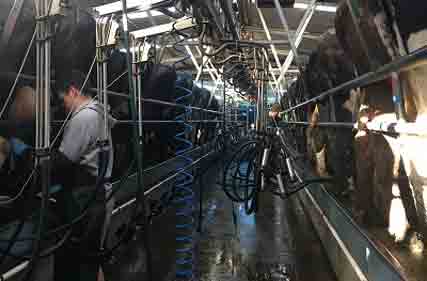
Just like your car, the dairy shed needs an energy tune-up now and then to keep it efficient.
Electricity is a major and unavoidable cost for dairy farms, and dairy farmers are under pressure from rising cost of electricity and concerns over energy security.
Reducing energy use on farm is one of the quickest and easiest ways to reduce farm emissions and costs. Real opportunities exist for dairy farmers to better control their energy costs and prepare for potential impacts on power supply.
This is while simultaneously reducing greenhouse gas emissions from energy use and capturing higher profits by using energy smarter.
The national average energy use on dairy farms is 48 kWh/kL of milk. The three main contributors to energy use within the dairy are milk cooling, hot water heating and milk harvesting, which is centred around milk pumps, vacuum pumps and air compressors that run stall gates.
Together – whether it’s an automatic or conventional milking system – they account for about 80 per cent of dairy shed energy costs, with the remaining coming from other areas such as cleaning and effluent, stock and dairy water, feed and sheds and lighting.
An energy audit can help identify where electricity is used on your farm and help inform your business decisions. Often these decisions will be a combination of strategies and fall into three main areas for improvement: using less energy, increasing energy efficiency, and getting the cheapest renewable source.
Reducing demand and minimising wasted energy can be achieved through measures such as turning off what is not needed and when not in use – as a simple start. One example is the use of the dairy air compressor.
Needed during milking, these are often left running all day, even when not in use. Most air compressor systems have leaks – so by turning them off between milkings, you’re minimising the run time and the amount of energy being wasted.
Finding and stopping those leaks – as well as other measures such as insulating pipes to stop heat gain, ensuring the right size vacuum pumps for dairy systems and regular maintenance of equipment – can all add up for some sizable energy use savings.
“An energy assessment or audit will identify your energy use and any leaks. Ongoing monitoring and maintenance is crucial to keep your energy use and costs in check,” says Dairy Australia’s National Climate and Energy Lead, Elissa McNamara.
Finding ways to better manage the main energy consumption areas in the dairy means looking for ways to maximise the operational efficiencies within the existing dairy system.
For example, with milk cooling accounting for around 20 to 30 percent of a dairy shed electricity use, for every one-degree (Celsius) improvement in pre-cooling can give an annual electricity saving of around $300 a year (based on a dairy producing two megalitres annually).Increasing efficiencies is about identifying if there is a better design of the diary system to reduce demand.
“Just like your car, the dairy shed needs an energy tune-up now and then to keep it efficient” says Elissa.
“Investing a few hours per week across four weeks each year to identify and address areas for maintenance or tune ups will make a noticeable improvement to the efficiency of your dairy shed.”
A good place to start is looking at one of new energy saving resources called Dairy shed easy energy tune-up fact sheet which provides guidance and some easy actions farmer can take to save on energy use including electrical metering, chiller cooling systems, water heating and vacuum pumps – simple actions that can improve your dairy shed energy efficiencies.
Where cost-effective, consider opportunities for use of renewables. This can be solar, wind, or biogas – noting that bioenergy is likely to only be a competitive option at a large scale.
Solar is globally recognised as the cheapest way to generate electricity and is shown to reduce electricity bills and provide a reasonable return on investment.
“Getting everyone in the dairy to think about energy efficiency is important. However, I urge farmers to do their homework before seeking quotes for any renewable projects,” Elissa says.
Any individual action taken in isolation may not result in any major changes, but routinely done together they can result in some significant savings – more than $500 to several thousands of dollars each year. Over several years, this payback is worth the regular maintenance.
The advice is simple: Keep a record of your energy use and the costs that go with it.
“If you’re not paying attention to your excess energy usage, you are effectively throwing money down the drain,” Elissa says.
Dairy Australia helps with managing climate and environment by delivering initiatives for efficiency of dairy farm inputs, such as water and energy, and supporting actions to reduce greenhouse gas emissions.
Dairy Australia has worked with energy experts to develop a range of resources to support dairy farmers with deciding when and where to target their efforts.
For more information and energy saving tips, visit Energy Saving Tips | Dairy Australia.
-Dairy Australia
